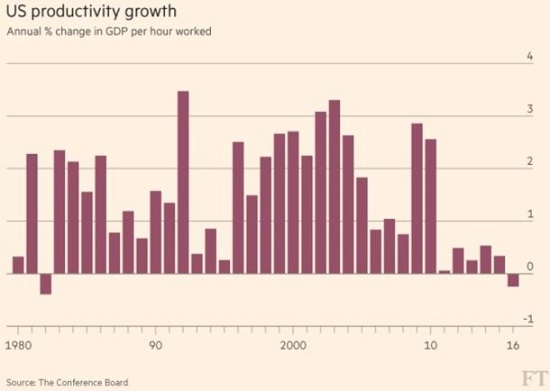Automation's Destruction Of Jobs: You Ain't Seen Nothing Yet...
Employers have no choice: it's innovate/automate or die.
従業員に選択の余地はない:技術革新かさもなくば死をだ。
Automation--networked robotics, software and processes--has already had a major impact on jobs. As this chart from my colleague Gordon T. Long illustrates, the rise of Internet technologies is reflected in the steady, long-term decline of the labor force participation rate-- the percentage of the populace that is actively in the labor market.
自動化ーーロボット、ソフトウエアそして工程がネットワーク接続されるーーこれはすでに雇用に大きな影響を与えている。このチャートは私の同僚Gordon T.Longが作った、インターネット技術の普及は継続しており、長期的に労働参加率は下がっているーー雇用市場に参加する人の割合だ。

The oft-repeated fantasy is that every new wave of technological innovation creates more jobs than it destroys. Not this time: the total number of full-time jobs has stagnated for years, and most of the new jobs that have been created are in low-wage, moderate-skill positions that cannot move the productivity needle much: jobs such as those in the retail and restaurant sectors.
現実離れした主張が度々繰り返される、技術革新の新たな波はそれによって失った雇用よりもさらに大きな雇用を生み出すと。今回は違う:常勤職の数はもう何年も停滞している、そして新規雇用の殆どは低賃金、低技能のもので、生産性を増やすことはない:こういう仕事は小売店や飲食店分野に多い。
Real wealth isn't created by printing currency or jacking up stock valuations--it's created by increasing productivity. As this chart reveals, productivity has stagnated for years. This is a complex dynamic, but we can surmise that the low-hanging fruit of automation has already been harvested, and the addition of jobs that are inherently limited in the productivity gains that can be achieved are core components in stagnating/declining productivity.
本当の富は紙幣印刷や株価押上で生み出されるものではないーー生産性向上によって生み出される。下のチャートを見れば解るが、生産性向上はもう何年も停滞している。この背景には複雑な事情があるが、私の解釈では、自動化による果実はすでに取り入れられ、新規雇用は生産性向上に限界のある分野だ、これが生産性向上の低迷/後退の主要因だ。

I have often discussed productivity and economist Michael Spence's framework of tradable and non-tradable labor. You want a beer-bottling machine? That's a tradable good; it can be manufactured anywhere in the world. You want a beer at the local tavern? That is non-tradable--it is a service that can only be provided locally.
私は生産性やMichael Spenceが言うところのフレームワーク、貿易可能労働と貿易不可労働、について議論することが多い。あなたはビールの自動充填機を望ましいと思うだろう?これは貿易可能商品だ;世界中のどこでも作ることができる。あなたは近所の飲み屋でビールを飲みたいと思うだろう?これは貿易不可能だーーこれは地元でしか提供できない。
The problem is non-tradable labor is typically impervious to productivity gains: even the most experienced bartenders can only draw so many beers and mix so many drinks in an hour. A retail salesperson can only help so many customers in an hours, a gardener can only mow so much lawn in an hour, and so on.
問題は、貿易不可労働というのは生産性向上に鈍感だ:たとえ経験豊かなバーテンダでも時間あたりに注げるビールの量や調合できるカクテルの量には限りがある。小売営業員が時間あたり対応できる顧客の数にも限界がある、庭師が時間あたり刈ることのできる芝生にも限りがある、という具合だ。
As Gordon and I discuss in our new video program, Robotics & Chronic Unemployment, automation is now entering these non-tradable sectors with a vengeance. Sectors dominated by non-tradable labor include taxis, local trucking, long-haul trucking, delivery services, courier services, retail, restaurants, fast food, and so on.
Gordonと私の議論が新たなビデオになっている、ロボット化と慢性的失業、自動化は今やこの貿易不可能分野にまで侵食している。貿易不可能雇用セクターとして、タクシー、近距離・長距離トラック、出前、宅配、小売、レストラン、ファストフード、等々がある。
Every one of these sectors is perched on the precipice of dramatic disruption by automation. Self-driving vehicles, drone deliveries, self-serve kiosks, robotic store clerks that have the entire store inventory available to answer customer questions--the list of automation advances in once-safe sectors is almost endless.
これらのどのセクターも自動化で劇的な変化を受ける瀬戸際に有る。自動運転自動車、ドローン配送、セルフサービスコンビニ、顧客の質問にすべての在庫状況を把握して対応できるロボット店員ーーこれまで不可能と思われていた分野にまで自動化の波が襲いつつ有りとどまるところを知らない。
The driver is the need for productivity increases. Labor costs keep rising, especially for labor-overhead expenses such as healthcare insurance and pensions. The cost of living keeps rising, pushing wages higher.
その駆動力は生産性向上だ。人件費は上がり続けている、特に医療保険や年金部門での間接人件費では顕著だ。生活費も上がり続けている、これが労賃を押し上げている。
If productivity can't be increased, the only alternative is to raise prices. But consumers, even at the high end, are reaching their limits. When meals that cost $20 now cost $30, consumers start opting for cheaper alternatives.
もし生産性向上できないなら、商品やサービス価格に点火するしか無い。しかし消費者はたとえ高収入のひとでも限界がある。これまでの食費が$20から$30になると、消費者は安い解決策を探すようになる。
Corporations and small businesses alike can only trim production costs and keep prices fixed for so long before profits vanish.
大企業も中小企業も価格を維持しようと生産コスト低減に励む、利益を失わないように。
Enter automation. The new technologies are now giving enterprises the tools to increase productivity in these previously low-productivity non-tradable sectors.
自動化採用。新技術導入でこれまで貿易不可能だった低生産性分野にまで新たな生産性向上手段を与える。
While we can collectively fret over this need to increase productivity and the resulting decline in paid labor, the employers have no choice: it's innovate/automate or die.
我々は生産性向上に頭を悩ませその結果人件費を削るわけで、従業員に選択の余地はない:自動化かさもなくば死をだ。
Even local, state and federal government agencies and contractors, heretofore impervious to soaring labor and overhead costs, are about to feel the urgent need to automate as a survival technique as budgets turn red in rising deficits and taxpayers revolt against ever-higher taxes.
たとえ地方政府やその契約企業でも、これまでは人件費や間接費増に鈍感だったが、財政状況が逼迫し生き残りのために自動化の必要に迫られている、納税者も高額納税を望んでいない。
There are no safe sectors any more because unrestrained cost increases are killing the economy. Healthcare is a runaway train, and all the buffers that enables prices to go to the moon are gone: we can't even afford the limited Medicare we have now, much less Medicare for All.
これから逃れられるセクターなど無い、コスト上昇に歯止めを賭けないと経済をだめにしてしまうからだ。医療部門が喫緊の課題だ、医療費上昇をもう吸収しきれなくなっている:現在のMedicare高齢者医療保険制度でも維持できない、全体のためにMedicareの質を落とさなければ。
It's not just low-skill jobs that are being destroyed. Look at the automation of financial services and trading. In the near future, if you want human service, you'll have to pay extra--if it's available at all.
いま無くなろうとしているのは低技能職だけではない。金融サービスやトレードでの自動化を見るがいい。近い将来、人の対応を望むなら別料金となるだろるーーそういうサービスが生き残ったとして。
There is a self-reinforcing dynamic to job losses and stagnating wages. As households receive less income, they must tighten their belts, further pressuring government and private enterprise alike to do more with less costly labor.
雇用損失と賃金低迷には自己完結的な力学が働く。家計収入が減ると、彼らは支出を抑えざるを得ない、これが政府や民間企業によりより低賃金を強いることになる。
Given a choice between a lower-cost automated service and a higher-cost human-labor service, the bottom 95% will have to choose the automated service.
自動化されたサービスと高額な人の対応サービスの間で選択を迫られると、下層95%は自動化サービスを選ばざるを得ないだろう。
If a fast-food meal at a kiosk is $5 and the one served by a human is $6, which will people choose? I have described the difference in my book Get a Job, Build a Real Career and Defy a Bewildering Economy: this setting is low-touch--the human interaction doesn't create much value for the customer, so they aren't willing to pay a premium for it.
コンビニのファストフードが$5で、人が給仕するサービスが$6だったとしよう、人はどちらを選ぶだろうか?この違いについて私は著作で議論した、「職を得て、経験を積み、混迷する経済に打ち勝つ」:ここで議論したのは、人の介在は顧客にそれほどの価値を提供しない、そのため余分な支払をすることを望まないだろう。
The same is true of most non-tradable sectors.
多くの貿易不可セクターについて同様のことが言える。
The coming destruction of jobs will be monumental, unstoppable and long-term. Gordon Long and I discuss the effects of robotics and automation on jobs in this 27-minute program:
これから訪れる雇用喪失はとても大きなものに成るだろう、誰求めることができず長期的に起きる。Gordon Longと私は自動化やロボット採用の雇用に与える影響についてこの27分の番組で議論している。










